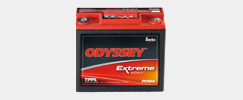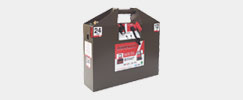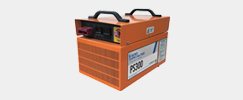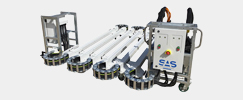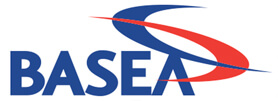
CAD (computer aided design) has transformed almost every aspect of the output of Powervamp, the leading manufacturer of aviation ground power units, emergency power systems, static frequency converters and automotive jump-starting equipment. Activities ranging from design conceptualisation to detailed product specification have been streamlined, and the benefits have been felt everywhere from the factory floor to the sales team and even the marketing department.
“In short, CAD has swept through every aspect of Powervamp’s activities, and has become central to everything we do….”
“Above all, our customers gain,” says Ian Stuart, one of the company’s mechanical CAD design engineer. “We can bring products to market more quickly. We can take cost out of our equipment by reducing material thickness and complexity.”
“We can simulate real-world performance to improve product durability and life expectancy. We can also develop bespoke designs more easily to meet the unique requirements from our customers.”

At the same time, he says, the rendering capabilities of CAD make it an ideal marketing tool. “We can create convincing three-dimensional design drawings to show customers our proposals. We can generate lifelike pictures of product variants before we’ve even built them, and use them in tender documents, brochures and marketing material allowing us to receive approval without the need for prototyping.”
“In some cases full 3D models can be emailed that will allow the client to manipulate the image to offer them a complete visualisation of the product. In short, CAD has swept through every aspect of Powervamp’s activities, and has become central to everything we do.”
“The software can analyse a design for access, ensuring a service engineer has the suitable freedom to test…”
Powervamp’s CAD system runs on conventional high-end PCs with large amounts of memory. It holds a “library” of components, fixings and existing designs, which Powervamp engineers have augmented with less mainstream equipment found in its specialised industry sector – aircraft electrical connectors, for instance.
Powervamp’s engineers are able to model these components themselves, harnessing the CAD package’s power and versatility.

When details of a new or updated product are uploaded, engineers now use the CAD system to ensure that all the components are fit for purpose, and can be assembled in a logical process.
“The software can be used to analyse a design for access, ensuring a service engineer has the suitable freedom to test, or replace, components where necessary. We can also check the implications of using different materials for any component,” Ian Stuart says.
Powervamp has gone beyond the basics with its CAD system, adding a module that applies finite element analysis to its designs. This allows its engineers to check point loads and to simulate vibration frequencies and the strength of welds. The system calculates the minimum requirements in terms of structural design and material thickness – reducing weight and cost, yet increasing life expectancy at the same time.
“CAD has even enabled us to identify unexpected air vortices where the air flow was not what we anticipated..”
So detailed is the CAD analysis that it can even take account of the extra thickness that painting or powder-coating will add to a component. “It might only increase the thickness of an individual item by as little as 0.2mm,” Ian says, “but when aggregated over multiple items, it could affect the viability of the intended design. CAD takes away the guesswork from this kind of calculation.”

Another specialist CAD module allows Powervamp to simulate airflow across and through its assemblies – an invaluable feature, since many of its products feature heat-generating components such as semi-conductors.
“We can investigate the way air flows over a heat sink,” Ian says. “We check whether it’s doing its job properly – absorbing heat that would otherwise compromise the life expectancy of the components it’s meant to protect.” The system can even take account of the ambient air temperature in different parts of the world”.
“There have been some surprises,” Ian says. “CAD has enabled us to identify unexpected air vortices, and instances where the air flow was not what we anticipated. These discoveries have now worked their way into design improvements.”
“The software can even simulate a product at midday in Dubai or in the afternoon in Somerset…”
It has been especially beneficial to have the CAD system on site at the Powervamp factory, rather than at a remote site run by external consultants, Ian points out. “We can run ‘what-if’ conceptualisations and costings relatively quickly, allowing the design team and production team to review the results face to face, and agree on design changes if any are necessary.
For instance, we might decide it would be desirable to reposition a button or a dial – the software allows us to make these decisions quickly.”

He adds: “Fine-tuning like this can have surprisingly wide-ranging knock-on effects, speeding up the whole product development process.”
In a recent application, Powervamp was asked to develop a special version of its Coolspool Hybrid 300 diesel ground power unit to be mounted on the back of a pickup truck, rather than using its own integral trailer. CAD enabled the company to mock up a suitable bespoke frame much more quickly than would have been possible using conventional engineering practices.
“The dedicated Powervamp CAD suite has brought so many benefits to the design process that it’s quickly become a way of life..”
CAD’s ability to generate convincing lifelike product images, often indistinguishable from photographs, has proved particularly appealing for Powervamp’s sales and marketing departments. “We can vary the focal length and depth of field of the virtual lens, add reflections, even simulate the intensity of light at different times of day,” Ian says.
“The software can even simulate a product at midday in Dubai or in the afternoon in Somerset, and we can add labels and decals to suit.” “The fact that we can create a virtual studio without the need to physically photograph a product, or object, has saved an enormous amount of time and resource.

Whilst “quick and dirty” simulations can be generated in a relatively short time, detailed photo-realistic images can sometimes take much longer to render, so the company utilises a dedicated powerful computer just for full simulations and rendering.
“It’s hard now to imagine life at Powervamp without CAD,” Ian says. “The dedicated Powervamp CAD suite has brought so many benefits to the design process that it’s quickly become a way of life for us allowing us to offer our customers quality products and cost effective bespoke solutions”



